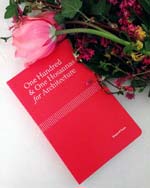
|

|
|
Home Site Search Contact Us Subscribe
|
|
Preface to "One Hundred & One Hosannas for Architecture" "It is a truism to say that journalism is the first draft of history. Historians always place great weight on contemporary accounts...a work of architecture is not complete until it has been written about." By Shane O'Toole May 4, 2017 Editor’s note: This is the preface to Shane O’Toole’s recently released – and well-received – One Hundred & One Hosannas for Architecture: A Chronicle of Architectural Culture in Millennial Ireland (Gandon Editions, 2017). It is a collection of his essays written between 1999 and 2016. In one of our e-mail exchanges when discussing this post, he wrote: “While obviously biased by the place I come from, the work and words are for, and come from, the world.” From the world, indeed. We’re enjoying the journey (and like the three ribbon bookmarks, too).
A stranger’s phone call changed my life. I didn’t recognize the caller’s name, but he soon made me an offer I couldn’t refuse. Michael Ross said he was revamping the Culture section of the Irish edition of The Sunday Times and wanted to include a fortnightly column about architecture. He thought I could write it. “The country is changing all around us,” he said – this was during the early days of the Celtic Tiger era – “and I sense that readers would like to know more about the how and the why.”
He asked me to become their fly-on-the-wall, to share the conversations that professionals, officials, and developers were having among themselves. There were a few conditions: no drawings and no architectural jargon, just plain English, but no dumbing down either. I should have faith in the intelligence of the readers. I could, for the most part, suggest my own topics. He allowed me to ferret out the best stories, but left me in no doubt about the one golden rule: “Your only loyalty must be to the reader,” he said, “not to your subject and not to your friends. If you once betray that trust,” he warned, “it can never be regained.”
Hosanna! What a wonderful brief I was offered that autumn afternoon. And with it came access to an audience of hundreds of thousands of curious, open-minded readers, in a section called Culture that was on its way to being the best writing platform in Irish journalism. Even now I pinch myself at the thought. I would have paid for the privilege.
My debut came less than a fortnight later, on October 10, 1999, in the first full-color edition of Culture. Lisa Godson began her Designer Ireland column the same day, with Eileen Gray’s Bibendum Chair. Mine was a review of Grafton Architects’ first monograph. Looking back, what pleases me most is that I managed to include in the piece a prescient quote from Kenneth Frampton’s introduction to the book:
One is aware of a local resurgence, and an enviable critical approach to the transformation of reality that has characterized the best of Irish architecture over the past decade. “The flag is in the breeze,” as Louis Sullivan once said of Chicago in an equally propitious moment. This is surely one way in which culture may be made, by penetrating into the grain of the place in every sense of the word and by cultivating societal desire, without which, little of substance can be achieved, for without the will of the client, nothing is possible.
There you have it. The flag was in the breeze. Irish architecture was in pretty good shape at the turn of the millennium, following the Temple Bar years, even if the news was still only beginning to leak out to a broader audience. The core ingredient – a close, almost forensic, obsession with the qualities that make places unique and give them character – was already there. Out of the next decade of boom and bust emerged a chronicle of a remarkable period in Irish architecture, when something rich and original was simmering away but was not yet fully cooked. Soon it would be served up for the whole world to enjoy.
Several themes quickly emerged in the pieces I was penning. The concerns weren’t pre-planned, as the paper always required a response to current events. Yet prompted by the publication of books and exhibitions as well as by building completions, the chronicle is shaped as much by the company of the past as by the present and is all the richer for it.
Recurring topics include architectural history, urban planning and the city, and the threat to Modernism’s built heritage, as well as conservation, contemporary art and architecture, and the critic’s traditional duties of recommending, affecting reputations, and spotting emerging talent. The chronicle took on the form of a cultural history, written up for the most part as news in a newspaper for an audience of readers that I imagined wanted a scholar writing for them.
Culture was the perfect section for that. With its TV and radio listings, it had a longer life than most newsprint, kept in the living room all week and dipped into daily. That pattern of domestic behavior already seems archaic, however. So this chronicle is also something of a lament, an elegy for a moment in journalism that has passed. Critics at newspapers – architecture critics, in particular – are dying off even faster than print journalism itself.
It is a truism to say that journalism is the first draft of history. Historians always place great weight on contemporary accounts. I would go further and suggest that even though very few buildings are ever reviewed, a work of architecture is not complete until it has been written about. Certainly, it cannot yet enter the canon. So in a certain way, when you are writing about architecture, you are completing the project. The architect develops the work to a stage of physical completion and then hands the building over to its users. At that point, the critic completes the job the architect has had to relinquish. In a way, it’s a bit like christening a baby. If the architect is the baby’s parent, you are giving her a name in front of the community, a name that she will carry around for the rest of her life.
The critic opens the public conversation, and gives it its initial direction. You are a bridge-builder between the object and its creators and the society in which you live. You occupy a privileged position as a representative of both contemporary society and the future culture, charged with explaining and making sense of a piece of architecture for the wider community. You also have to communicate your love of things and in so doing, instil love in others, while never forgetting that, as American critic Paul Goldberger has reminded us, every object is both a physical thing and a political thing, and has to be understood and criticized as both.
The process of criticism provides a master education for the critic. Through meeting architects, visiting buildings and thinking as deeply as you can about them, you learn more than you could ever have hoped, while having wonderful fun at the same time. I write to find out about things, but I also write for the pleasure of a piece well written, just as good architects will design a building because there's a need for it, but also really for their own pleasure, and in the hope of discovering something new. Both activities are artistic endeavors.
At the end of the day, if a critical piece is not a pleasure to read, it is a failure in my eyes, a missed opportunity. A good review should aim to offer the reader something of the pleasure and realization that a good poem affords. And that means you have to play with language, you have to be as inventive with words as an architect is with bricks and mortar or concrete or copper or steel, if you are to transport the reader from a dull, banal, technical description of a building to an emotional understanding of architecture. That's where you want to go.
There are many different definitions of criticism and the work of the critic, probably as many as there are critics themselves. Perhaps my favorite was contained in an appreciation in The Washington Post for one of its critics who died in 2005. It ran under the heading “Joseph McLellan Heard the Best in Music and People”:
Joe was aware that he was sometimes viewed as a cheerleader. Instead, he likened his role to that of a gardener. “The critic notices what needs to be watered, pruned, and fertilized,” he said in an extensive interview published by Washingtonian magazine in 2001. “At the end of his time, the garden should reflect the values he embodied.”
SOT Shankill Castle, Kilkenny February 2017 |
(click on pictures to enlarge)  Alice O’Toole “One Hundred & One Hosannas for Architecture”  Alex Sapienza Shane O’Toole |
© 2017 ArchNewsNow.com